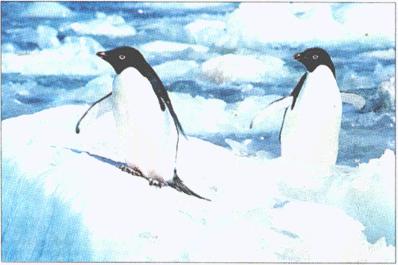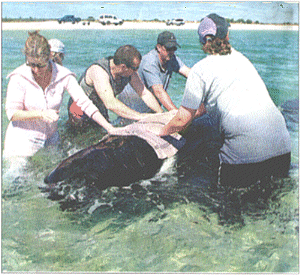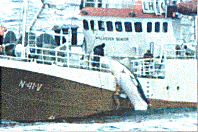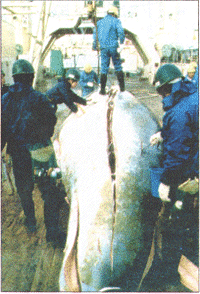
Protests as a million seals face slaughter |
BY JAYNE ATHERTON
PROTESTERS were out in force yesterday as Canada began one of its biggest seal culls in decades. The government claims hunting methods using rifles and spears are humane and up to a million seals can be killed over three years. The seal population is reaching a record level which has caused a collapse in commercial fish stocks, supporters say.But animal rights campaigners want a boycott of Canadian seafood. They say many animals are clubbed then skinned alive to die in agony. The two-month hunt takes place on ice floes in the Gulf of St Lawrence, off the Atlantic coast, where seals give birth. Ottawa's department of fisheries and oceans said: 'The harp seal herd is estimated at about five million animals, nearly the highest ever rocorded, and almost triple what it was in the Seventies.'
Large-scale hunting will be allowed to continue until the number falls below
four million. 'Canada's seal population is healthy and abundant,' said assistant deputy fisheries minister David Bevan. But a report by the International Fund for Animal Welfare says the cull will irreversibly damage their population. 'We are encouraging consumers say to their grocery stores and restaurants, "Please don't serve Canadian seafood",' said Pat Ragan, of the Humane Society of the US.
The seal hunt in Newfoundland and Labrador weat into decline 25 years ago,
after irnages of hunters clubbing infant seals horrified TV viewers around
the world.
TOUGH MEASURES NEEDED TO PROTECT RAPIDLY DEPLETING FISH STOCKS Seal cull 'essential'
Dan Castellarin, London W1 Dan is one of those totally ignorant of population dynamics - and as usual is talking out of selfish greed,superiority of the human race - specieism - and total ignorance of ethical philosophy not to mention the wrong orifice.
· The World Society for the Protection of Animals (WSPA) works to end forms of cruelty to animals overseas, so Canada's decision to allow the biggest seal cull for more than 50 years can only he a huge backwards step inanimal welfare. Not only is this one of the largest slaughters of marine mammals on the planet but the methods used often subject the seals to a great deal of suffering. An independent veterinary study in 2001 found that 42 per cent of these animals are skinned alive. The Canadian government justifies the cull by claiming seals destroy cod stocks. But there is no scientific support for this. In fact, scientific evidence has shown the cause is over-fishing. I urge readers t help put a stop to this by writing to the Canadian High Commission, 38 Grosvenor Street, London, W1K 4AA.
Philip Lymbery, director of communications, · Given that cod stocks are dwindling and dolphins appear to be two-a-penny, why don't we simply stop eating the former and start dining on the latter? Dolphin meat is not dissimilar to tuna and, given it is full of protein, I would venture it is considerably more nutritious than cod. Not only this, but their hides could also be fashioned into waterproof overgarrnents. Dean Hunt, London SE1 [Metro 4Apr,2005]
Contact these organisations to protest against the cull IFAW | Harp Seals | Seal Sanctuary | Sea Shepherds
Dozens of porpoises beaten to death on British coast
LONDON (AFP) - British police said they had found 30 porpoises beaten to death along the Yorkshire coast in eastern England, sparking fears of torture of the protected mammals. The bodies of the harbor porpoises were found over the past few weeks in the Barmston area, a police spokeswoman said, adding that one appeared to have died from a gunshot wound to the head. "A number of these mammals had suffered fatal injuries which appear to be as a result of a blow to the head," she said. The porpoises, whose numbers have declined in the North Sea and North Atlantic due to fishing nets, coastal development and pollution, are protected by Britain's 1981
My comment - The seal cullers along with
fox hunters seem to be oblivious to
how population
dynamics actually works not to mention ignorant of
the moral philosophy of the Western
Civilisation.The reasons they give for culling are in actual fact false
and most of the argumens they make are silly and put mankind's welfare before
that of animals - this is
SPECIESISM
and is one of the last frontiers of morality facing human kind - our actions
towards animals are an endictment of how we are prepared to
treat each other. Those who are prepared to treat animals like this do not
seem to be aware of how complex a biosphere
they are messing with.It is also highly ironic that whilst the Canadians
are the one's brutalising seals because of supposed depleting of
fish stocks,their countrymen are also at the frontiers of understanding
the kind of complexity and dynamics that not only explains population
dynamics but results in virtual simulated
fish! It is absurd to chastise seals for only doing what they do naturall
to survive - if there were not enough fish to feed them - they would
not be alive - I have been living without eating fish or meat products
for over 20 years - mankind - although omnivore can choose what his diet
is - Seals cannot - human beings should show compassion - this is the
one thing hunters seem to think seperates us from creatures - being
able to think and decide - it is odd then when it would actually make
sense to - the hunters act exactly like the creatures they say they are different
from -and brutally kill something.To me - animals have the upper hand - if
a man was in distress from a shark - a dolphin or seal would most likely
help him - and how do we repay them - with comments like that of Dean
Hunt's - perhaps his name is rhyming slang for something appropriate.
SURFERS wobbled and spectators rose to their feet when a group of dolphins muscled in on a surfing competition in Cornwall. Tommy Campbell, 47, went along to photograph his 13 year- old son Stuart at the fundraising event. He said:
'Suddenly, the dolpins were there in the middle of the competition, playing
with the surfers and clowning around. They were going underneath the boards
and jumping out of the water on the other side.' The extraordinary sight
drew cheers from 2,000 spectators on Fistral Beach in Newquay. Around 200
surfers took part and raised £10,000 on Sunday. |
BY SUZY AUSTIN
 PENGUIN
colonies threatened by a giant ice blockage could be saved because it appears
to be moving away, officials said yesterday.
PENGUIN
colonies threatened by a giant ice blockage could be saved because it appears
to be moving away, officials said yesterday.
Tens of thousands of Adele chicks faced starvation when the world's biggest iceberg ran aground three months ago in the Antarctic.
Parent birds were forced to trudge about 180km to find open water and gather food.
Scientists are still trying to find out how many starved.
But there is now hope for future generations of the flight1ess seabirds as the B15A iceberg moves slowly out of McMurdo Sound.
The 3,000 sq km mass - which contains enough water to supply the Nile for 80 years - blocked wind and water currents, causin a build-up of ice. It also prevented ships from supplying food and fuel to staff on three US, New Zealand and Italian research stations. Two icebreakers eventually managed to smash a 50km track through the ice to McMurdo Pier, enabling skips to deliver supplies.
As B15A approached in January, scientists feared it would collide with a 70km glacier. The iceberg is nearing the Drygalski Ice Tongue glacier at a speed of about 1km per day, but a direct hit now seems less likely.
'It still hasn't cleared out of the area, but it's moving in the right direction,' said Lou Sanson, chief executive of government scientific agency Antarctica New Zealand.
'We know very little about what makes this thing tick.Every time someone has made a prediction about the berg, they've been proved wrong.' [Metro Apr5,2005]
Beached whales swim out to sea
 A
POD of whales stranded on a beach swam back out to sea yesterday after six
of them died. The 13 remaining mammals were corralled in shallow waters by
swimmers and surfers who were able to push them 150m away from the coast.
A motor boat herded them into deeper water, where they will be monitored
from the air. Nineteen whales, some measuring up to 7m, were found on Sunday.
A
POD of whales stranded on a beach swam back out to sea yesterday after six
of them died. The 13 remaining mammals were corralled in shallow waters by
swimmers and surfers who were able to push them 150m away from the coast.
A motor boat herded them into deeper water, where they will be monitored
from the air. Nineteen whales, some measuring up to 7m, were found on Sunday.
Four were already dead and two more died before nightfall. Vets and about 120 volunteers worked to help the rest survive. The whales had reached in Geographe Bay, 233km south of the Western Australia state capital, Perth.
'We haven't lost any more animals so everything is looking rosy,' a conservation official said. The cause of such mass whale strandings is not known. [Metro Apr5,2005]

Greenpeace co-founder dies
THE co-founder of Greenpeace died at 63 yesterday after a battle with prostate
cancer. Canadian journalist Bob Hunter helped launch the organisation with
a campaign against nuclear testing in 1971. He becance its first president,
watching it grow into a global body with 2.5million members in 40 countries.
He also lobbied against the hunting of whales and seals. 'This was a man
with a great loving heart and a massive spirit,' said friend and colleague
Stephen Hurlbut.
[Metro May 4,2005]
Killer that bit off more than it could chew
BY SUZY AUSTIN
Its powerful jaw and huge incisor teeth should have elevated it into the pantheon of the world's rnost terrifying beasts. After all, the little-known marsupial lion could out-bite the sabre-tooth tiger, the spotted hyena and the Tasmanian Devil, Now, researchers have found, the 130kg ice age cat which had a pouch for its young-has the most powerful bite of any other living or extinct anirnal. Its bite force was compared with 38 species by studying skull measurements Scientists found its jaws were much stronger than any other for its size - slamming shut on prey up to 20 times bigger. 'We were surprised at just how hard they were biting given their size was that of a rugby forward,' said researcher Dr Stephen Wroe. His Australian and Canadian research team predicted its biggest prey would have been the diprotodon, a gigantic wombat-like creature which could weigh 3,000kg.
The lion was the largest mammal predator in Australia during the ice age and became extinct about 45,000 years ago.
The findings are published in the online Proceedings of the Royal Society series.
Monkeys taught to spend and gamble
BY OLIVER STALLWOOD
CITY traders and shoppers may be guilty of behaving a bit like
animals when it comes to parting with cash. There may be a good reason, say
economists, who taught monkeys
how to spend and gamble
- and found they behaved just like people. |
SOME misogynists might say all
women are spongers... but in the dolphin world
there is a grain of truth to the claim. The female mammals have perfected
the art of sponge-foraging - using marine sponges to sweep the oeean floor
for fish. They pass on the skill from generation to generation but the men
are too busy to learn. Scientists say it is the first recorded case of a
marine animal using a tool - so-called material culture. It has previously
been observed only in humans and animals such as chimpanzees, which use sticks
and stones. Bottlenose dolphins from Shark Bay, off the coast of western
Australia, becak off the sponges and wear them over their snouts to probe
the sea floor for fish. The University of Zurich team to the Proceedings
Of The National Academy Of Sciences journal males probably did not bother
to learn sponge-foraging because they had busy social lives. |
||||
** Monkey Hear, Monkey Count
Rhesus monkeys possess a natural ability to match the number of voices they hear to the number of individuals they expect to see vocalizing, new research concludes. The results indicate that abstract representation of numbers is possible in the absence of language.
http://cl.exct.net/?ffcd16-fe6c16737767037d7516-fe2b16707360067e721779
BY SARAH HILLS
THE horrors of whaling were laid bare yesterday by animal rights activists
who secretly filmed the brutal killing of a minke whale.
The footage appears to contradict claims by pro-whaling nations such as Norway
and Japan that the animals are culled as quickly and painlessly, with death
coming about two minutes after they are harpooned.
The video was shot last month by a team working for the World Society for the Protection of Animals and the Enviromnental Investigation Agency. The groups claim more than 25,000 whales have been slaughtered since a ban on commercial hunting came into force in 1986.
Investigator Clive Lonsdale said they followed a licensed whaling vessel off the coast of northem Norway after a tip-off that female whales - which are more popular with hunters because of their size - were in the area.
 The
tape shows one cow being blasted with a grenade-tipped harpoon.
The
tape shows one cow being blasted with a grenade-tipped harpoon.
As she repeatedly resurfaces and splashes frantically, fishermen shoot her seven times with a rifle. Her agonising death takes about 14 minutes.
Mr Lonsdale said: 'The whalers were in about 20m of water as the whales fed on fish. They were sitting for about 90 minutes, waiting for her to surface, then the boat charged her down.
'About three or four minutes after she was harpooned, she surfaced again close to the boat. It was clear the crew had misfired. The whale was still alive but was tethered to the boat and must have been in agony. For 15 minutes before she died, she continued coming up to the surface and every time she was shot at with a rifle.
'It was very traumatic. I was focused on the job but, when I watched the video again, it made me cry.' he added
The dead minke was hauled on to the boat and cut up for sale locally.
Leah Garces, of the WSPA, said:
'This footage is further proof - as if any were necessary - that there is no humane way to kill a whale and all commercial and scientific whaling should cease on grounds of cruelty alone.'
Slow death: After a 14-minute pursUit, the dead Ininke is hoisted on to a boat of northern Norway

Hunters want culling ban lifted
THE video was released before an International Whaling Commission meeting next week, where pro-hunting nations Japan, Norway and Iceland will push for the 19-year ban to be lifted.The Japanese, who consider whale meat a delicacy, wants to resume commercial hunting and double the number of whales they catch for research. But Australia opposes the plan and Canberra's environment minister Ian Campbell has spent weeks lobbying other nations for support. Under an international agreement, there is a moratorium on commercial hunting of whales, although some can be killed for scientific research. Norway, Iceland and Japan want the ban partly lifted, arguing that stocks of some species have recovered enough to make hunting sustainable. Under its research quota, Japan wants to start hunting fin and humpback whales and to raise its annual intake of minkes.
Related Articles |